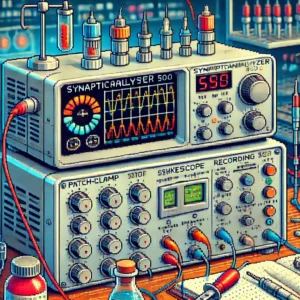Publications
View a full list of our publications here.
Major Research Themes
1) Navigation

Learning where you need to go and remembering how to get there is critical for survival. We study navigation in complex environments to better understand the role of the hippocampus and related structures in achieving these goals.
2) Foraging

An efficient forager must balance the tradeoff between exploiting known resource patches and exploring new ones, minimize energy and time spent traveling or searching, and adapt to environmental uncertainties such as resource scarcity and unpredictable distributions, all while accounting for risks like predation. We study this complex form of decision making using a range of different approaches, including maze and operant-box versions of foraging problems.
3) Info on more projects coming soon!![]()
THE LABORATORY

Our lab is equipped with state-of-the-art computational tools. Here’s just some of our computational resources:
Mainframe System
Processor: Custom-designed QuantumLogic CPU, 16-bit architecture, 5 MHz clock speed, 1 MB core memory (expandable!)
Storage: 200 MB disk storage array using MaxSpindle Disk Drives (removable platters), 100 MB magnetic tape drive by Apex Data Systems (9-track reel-to-reel)
Operating System: OmniCore OS/3, with multi-user time-sharing capability
Terminals Supported: Up to 16 asynchronous terminals
Minicomputer Cluster
2 x MicroNova Systems MiniStation 800 (8 MHz 16-bit processor)
1 x TekCom Apollo-5 (Dual 12-bit processors running in parallel)
Interfaces: RS-232 serial ports, IEEE-488 for peripherals
Purpose: Data acquisition, laboratory automation, and preprocessing for the mainframe
Network Type: TokenRingNet proprietary loop by InterTech Solutions
Software
Support for FORTRAN-77, COBOL, BASIC, Pascal, DataForge DB/1 (relational database management)
Office Suite: WordWizard Pro and CalcMatrix 2.0 for word processing and spreadsheets
CircuitSim CAD for engineering
StatSuite+ for statistical analysis
ChartWorx for graphical plotting

Of course we have a range of equipment for measuring neural signals in vivo. Here’s a small sampling of our neural measurement capabilities:
NeuroDyn systems multi-channel recording system
Channels: 16^4-channel input
Sampling Rate: 10 kHz per channel
Resolution: 8-bit analog-to-digital conversion
Filter Options: High-pass (300 Hz) and low-pass (3 kHz) configurable filters
Interface: RS-232 for direct connection to mainframe or minicomputer
Feature: Real-time spike detection and sorting algorithm via OmniCore OS plugin.
SynapTech PulseGen 2000 Programmable stimulator
Output Modes: Constant current, biphasic, and monophasic pulse options
Range: 1 µA to 10 mA
Timing: Resolution of 0.1 ms with adjustable train duration
Control: Command interface via TokenRingNet and compatible with StarTerminal workstations.
Special Feature: Custom waveform generation for optogenetic, chemogenetic, electrical, or magnetic stimulation.
Biogrid neural signal amplifier and artifact rejection system
Gain: Configurable up to 100,000x
Filters: Adaptive noise cancelation and comb filters for 50/60 Hz interference
Latency: 5 ms real-time processing
Connectivity: Plug-and-play with PaperJet 240 for real-time analog signal plotting
Feature: Modular design for combining with SpikeScope systems.
NeuroLocker 800 stimulus delivery system
Display: CRT-based, 100 Hz refresh rate, grayscale luminance adjustment
Audio: Precision timing via 16-bit DAC, stereo output
Control: Multi-modal presentation software on OmniCore OS/3.
Feature: Synchronization with PulseGen 2000 for closed-loop experiments.
Hearken unto these spikes!:
